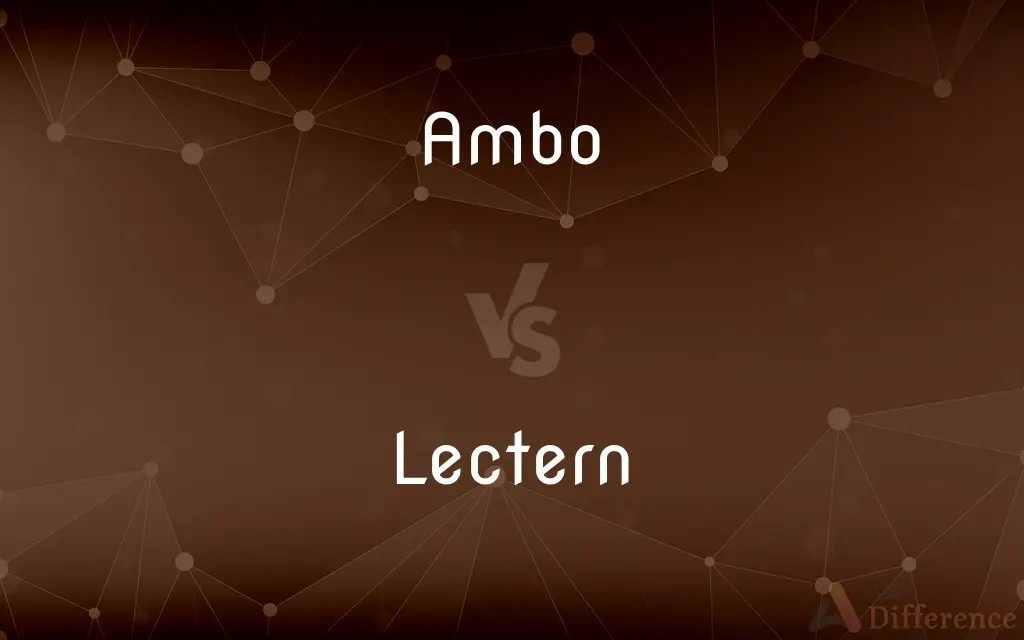Ambo vs. Lectern — What's the Difference?
By Fiza Rafique & Urooj Arif — Updated on April 18, 2024
An ambo is a liturgical stand used in early Christian and Byzantine churches for reading scriptures, while a lectern is a stand used in various speaking engagements to hold notes or books.

Difference Between Ambo and Lectern
Table of Contents
ADVERTISEMENT
Key Differences
An ambo, traditionally found in early Christian and Byzantine churches, serves specifically for the liturgical readings of scriptures, prayers, and sometimes the gospel. In contrast, a lectern is a versatile stand used in various contexts, from academic lectures to business presentations, to support reading materials or notes.
The design of an ambo is often elaborate, reflecting its religious significance and permanent placement within the church's architecture. On the other hand, lecterns are typically more functional in design, and can be either permanent fixtures or portable, depending on the needs of the venue.
Ambos are usually made of stone or marble and are often part of a church's structure, indicating their importance in religious ceremonies. Lecterns, however, can be made from a variety of materials including wood, metal, or plastic, highlighting their utilitarian purpose.
In religious contexts, the ambo is integral to the liturgy, emphasizing the sanctity of the readings; it is not merely functional but also symbolic. Meanwhile, the lectern's role is more pragmatic, designed to facilitate speech delivery regardless of the setting, without intrinsic symbolic value.
While the ambo is primarily used in Orthodox Christian and some older Catholic churches, the lectern has widespread use across different religions, educational institutions, and even in corporate settings, reflecting its universal functionality.
ADVERTISEMENT
Comparison Chart
Primary Use
Liturgical readings in churches
Holding notes/books in various speaking events
Design
Often elaborate and integrated into church architecture
Functional, ranging from simple to sophisticated, portable or fixed
Material
Typically stone or marble
Varied: wood, metal, plastic
Context of Use
Mainly in religious ceremonies
Diverse: educational, religious, corporate
Symbolic Value
High, specific to religious texts
Generally low, focused on functionality
Compare with Definitions
Ambo
Used exclusively within a liturgical context.
The choir sang from the side of the ambo during the service.
Lectern
Utilitarian in design, focusing on speaker’s ease.
The lectern had a small light and a shelf for holding water.
Ambo
Historically, a prominent architectural feature made of stone or marble.
The ancient ambo at the cathedral is adorned with intricate carvings.
Lectern
Does not generally hold symbolic value but is key to effective delivery.
He placed his notes on the lectern, ready to address the audience.
Ambo
A raised stand in early Christian and Byzantine churches used for reading the Gospel or the Epistle.
The priest approached the ambo to read the day’s scripture.
Lectern
Made from a variety of materials to suit different purposes.
The wooden lectern in the library hall adds a touch of elegance to the room.
Ambo
Symbolizes a sacred space within the worship area.
The congregation faced the ambo as the readings began.
Lectern
A stand used to support a speaker's notes or books during a presentation.
She adjusted the microphone on the lectern before beginning her lecture.
Ambo
Positioned centrally or to the side in the church.
The ambo, positioned to the left of the altar, was beautifully illuminated.
Lectern
Portable or fixed, often found in schools, churches, and conference rooms.
The conference room was equipped with a modern, adjustable lectern.
Ambo
A raised speaking stand in a church, especially such a stand in early Christian churches serving as a lectern or pulpit.
Lectern
A lectern (from the Latin lectus, past participle of legere, "to read") is a reading desk, with a slanted top, usually placed on a stand or affixed to some other form of support, on which documents or books are placed as support for reading aloud, as in a scripture reading, lecture, or sermon. To facilitate eye contact and improve posture when facing an audience, lecterns may have adjustable height and slant.
Ambo
A raised platform in an early Christian church, as well as in the Eastern Orthodox, Oriental Orthodox, and Eastern Catholic churches.
Lectern
A tall stand with a sloping top to hold a book or notes, from which someone, typically a preacher or lecturer, can read while standing up.
Ambo
(Roman Catholicism) A stationary podium used for readings and homilies.
Lectern
A reading desk with a slanted top used to hold a sacred text from which passages are read in a religious service.
Ambo
(informal) An ambulance driver.
Lectern
A stand that serves as a support for the notes or books of a speaker.
Ambo
(informal) An ambulance.
Lectern
A stand with a slanted top used to support a bible from which passages are read during a church service.
Ambo
A large pulpit or reading desk, in the early Christian churches.
Lectern
A similar stand to support a lecturer's notes.
Ambo
A platform raised above the surrounding level to give prominence to the person on it
Lectern
A choir desk, or reading desk, in some churches, from which the lections, or Scripture lessons, are chanted or read.
Lectern
A reading desk, usually in the form of a stand with a slanted top that holds books or lecture notes at a height convenient for reading by a speaker who is standing. A modern lectern may be of adjustable height, and be fitted with a light to illuminate the material on the desk, and sometimes a microphone or other electrical equipment for use of a speaker.
Lectern
Desk or stand with a slanted top used to hold a text at the proper height for a lecturer
Common Curiosities
What materials are ambos usually made from?
Ambos are usually crafted from durable materials like stone or marble.
Can a lectern be used in religious settings?
Yes, lecterns are often used in religious settings alongside secular ones, for sermons and other speeches.
Where would you typically find an ambo?
Ambos are typically found in Christian Orthodox and traditional Catholic churches.
Is a lectern considered a permanent fixture?
A lectern can be either a permanent fixture or a portable unit, depending on its intended use.
Can ambos be made from materials other than stone?
While traditionally made from stone, modern ambos can also be crafted from other durable materials, though less commonly.
Are lecterns portable?
Lecterns can be either portable or fixed, depending on their design and the needs of the venue.
What symbolic significance does an ambo hold?
The ambo holds significant symbolic value in liturgy, representing the sanctity of the scriptures being read.
Which is more likely to be customized, an ambo or a lectern?
Lecterns are more likely to be customized to fit various functional needs and aesthetic preferences.
What is the main difference between an ambo and a lectern?
An ambo is specifically used in religious contexts for liturgical readings, while a lectern is used in a variety of settings for holding speaker notes or books.
How does the design of an ambo differ from that of a lectern?
Ambos typically have an elaborate design, reflecting their religious importance, whereas lecterns have a more utilitarian and versatile design.
Does the lectern have any symbolic or religious value?
Generally, lecterns do not hold intrinsic symbolic or religious value, focusing more on functionality.
Can the design of an ambo influence church architecture?
Yes, the design of an ambo can significantly influence the overall architectural style and interior layout of a church.
How has the use of lecterns evolved over time?
Over time, lecterns have evolved from simple stands to sophisticated platforms that can include technology integration for modern presentations.
Are ambos used outside of religious services?
Ambos are not typically used outside of religious services due to their specific liturgical purpose.
What features might a lectern have to aid in presentations?
Lecterns might include features like adjustable height, built-in microphones, or lighting to aid speakers.
Share Your Discovery

Previous Comparison
Adventurous vs. Courageous
Next Comparison
Mil vs. MileAuthor Spotlight
Written by
Fiza RafiqueFiza Rafique is a skilled content writer at AskDifference.com, where she meticulously refines and enhances written pieces. Drawing from her vast editorial expertise, Fiza ensures clarity, accuracy, and precision in every article. Passionate about language, she continually seeks to elevate the quality of content for readers worldwide.
Co-written by
Urooj ArifUrooj is a skilled content writer at Ask Difference, known for her exceptional ability to simplify complex topics into engaging and informative content. With a passion for research and a flair for clear, concise writing, she consistently delivers articles that resonate with our diverse audience.















































